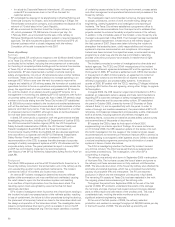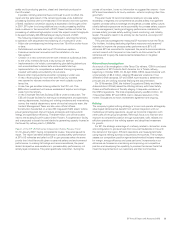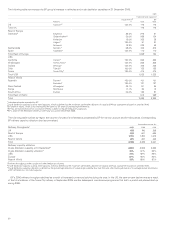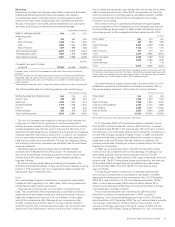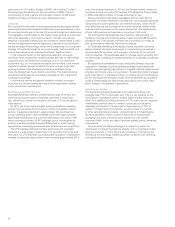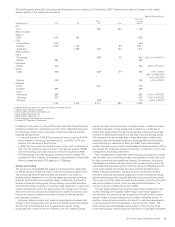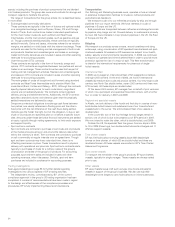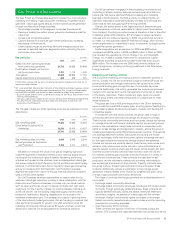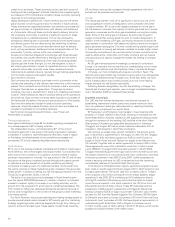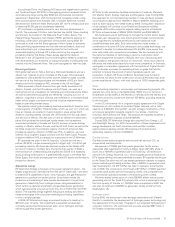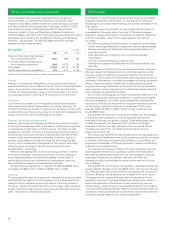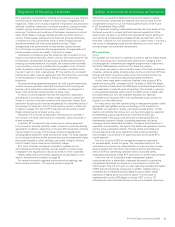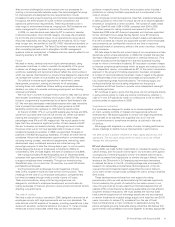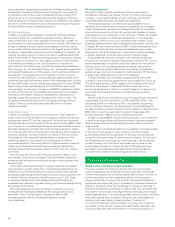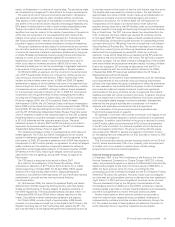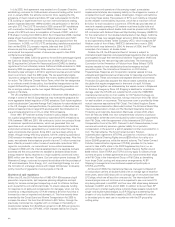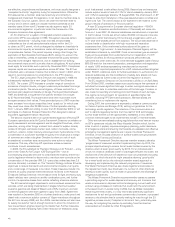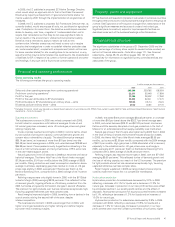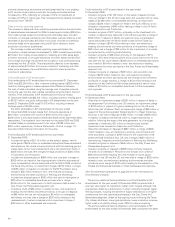BP 2006 Annual Report Download - page 40
Download and view the complete annual report
Please find page 40 of the 2006 BP annual report below. You can navigate through the pages in the report by either clicking on the pages listed below, or by using the keyword search tool below to find specific information within the annual report.
Other businesses and corporate
Other businesses and corporate comprises Finance, the group’s
aluminium asset, its investments in PetroChina and Sinopec (both
divested in early 2004), interest income and costs relating to corporate
activities worldwide. Following the sale of Innovene to INEOS in 2005,
three equity-accounted entities (Shanghai SECCO Petrochemical
Company Limited in China and Polyethylene Malaysia Sdn Bhd and
Ethylene Malaysia Sdn Bhd, both in Malaysia) previously reported in Other
businesses and corporate were transferred to Refining and Marketing,
effective 1 January 2006. The 2005 and 2004 data below has been
restated to reflect these transfers.
Key statistics $million
--------------------------------------------------------------------------------------------------------------------------------------------------
2006 2005 2004
--------------------------------------------------------------------------------------------------------------------------------------------------
Sales and other operating revenues
for continuing operations 1,009 668 546
Profit (loss) before interest and tax
from continuing operations
a
(885) (1,237) 155
Total assets 14,184 12,144 21,795
Capital expenditure and acquisitions 281 817 2,130
aIncludes profit after interest and tax of equity-accounted entities.
Finance
Finance co-ordinates the management of the group’s major financial
assets and liabilities. From locations in the UK, the US and the Asia Pacific
region, it provides the link between BP and the international financial
markets and makes available a range of financial services to the group,
including supporting the financing of BP’s projects around the world.
Aluminium
Our aluminium business is a non-integrated producer and marketer of
rolled aluminium products, headquartered in Louisville, Kentucky, US.
Production facilities are located in Logan County, Kentucky, and are jointly
owned with Novelis. The primary activity of our aluminium business is the
supply of aluminium coil to the beverage can business.
Research, technology and engineering
Research, technology and engineering activities are carried out by each
of the major business segments on the basis of a distributed programme
co-ordinated by a technology co-ordination group. This body provides
leadership for scientific, technical and engineering activities throughout
the group and in particular promotes cross-business initiatives and the
transfer of best practice between businesses. In addition, a group of
eminent industrialists and academics forms the Technology Advisory
Council, which advises senior management on the state of technology
within the group and helps to identify current trends and future
developments in technology.
Research and development is carried out using a balance of internal
and external resources. Involving third parties in the various steps of
technology development and application enables a wider range of
technology solutions to be considered and implemented, improving
the productivity of research and development activities.
Across the group, expenditure on research for 2006 was $395 million,
compared with $502 million in 2005 and $439 million in 2004.
Insurance
The group generally restricts its purchase of insurance to situations where
this is required for legal or contractual reasons. This is because external
insurance is not considered an economic means of financing losses for
the group. Losses will therefore be borne as they arise, rather than being
spread over time through insurance premiums with attendant transaction
costs. This position is reviewed periodically.
Technology
The realization of technological advancements is pivotal to our strategic
progress and business performance. It is also the key to finding and
developing solutions that meet the energy and climate challenges of the
21st century.
The sheer range and complexity of technologies that can affect our
businesses and the wide variety of sources for these technologies –
proprietary, energy service sector, universities and research institutions
and other industries – mean that no single approach can meet all
our needs.
The following guiding principles underpin our approach to technology:
– Deliver technology leadership in a select few areas of distinctiveness.
– Develop innovative and sustainable technology-based solutions for
corporate renewal.
– Drive rapid take-up of proprietary and commercially available
technologies.
– Innovate and test technology at material scale.
– Develop and access world-class skills and collaborate internally and
externally.
These principles are reflected in how we define technology investment.
Whereas research and development is an externally reported number,
internally we use a broader but very specific definition for technology
investment. This consists of four elements: technology development for
incremental improvement of our base businesses; technology leadership
areas to create and sustain material, advantaged business positions;
long-term technology investments to secure our future; and application
and propagation of technology through formalized technology networks
and knowledge management processes.
Our five-year technology plan provides for sustained investment in our
core technologies and increasing investment in long-term technologies.
As we have deepened our current areas of leadership, extended their
application in the field and broadened our long-term technology portfolio,
our technology investment has grown at an average of 15% a year
between 2003 and 2006. In 2006, total technology investment was
around $890 million.
During 2006, we continued to advance and employ new technologies
in drilling and well construction, unconventional gas development,
enhanced oil recovery and seismic imaging. These technologies have
enabled discoveries in the deepwater Gulf of Mexico and Angola,
increased production from tight gas fields in the continental US and
increased recoveries from our fields in maturing basins, such as
Alaska and the North Sea.
Technology advancements are also broadening our refining capability to
understand and process ever-lower quality crudes and optimize our assets
in real time, enhancing the flexibility and reliability of our refineries. Our
proprietary technologies in PTA have continued to reduce manufacturing
costs and environmental impact.
Our long-term technology priorities fit into three categories of activity:
technologies that enhance our capability to identify new hydrocarbon
resources and better exploit those we have; technologies that convert
hydrocarbon feedstocks into efficient fuels and chemicals; and
selected low-carbon technologies for power and transport to minimize
CO
2
emissions.
During 2006, we announced plans to establish a dedicated biosciences
energy research laboratory and invest $500 million over the next 10 years.
On 1 February 2007, BP announced that it had selected the University of
California, Berkeley, and its partners the University of Illinois at Urbana-
Champaign and the Lawrence Berkeley National Laboratory, for the
research programme. The Energy Biosciences Institute’s aim will be to
explore the application of bioscience and the production of new and
cleaner energy, initially focusing on renewable biofuels for road transport.
It will also pursue bioscience-based research in three other key areas: the
conversion of heavy hydrocarbons to clean fuels; improved recovery from
existing oil and gas reservoirs; and carbon sequestration.
38


